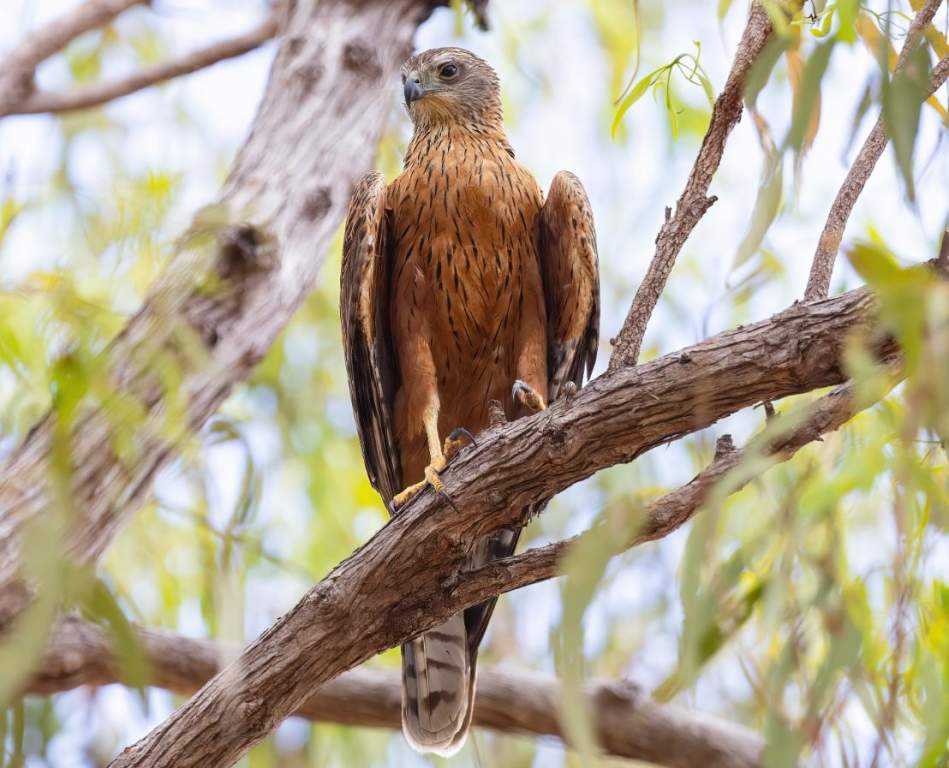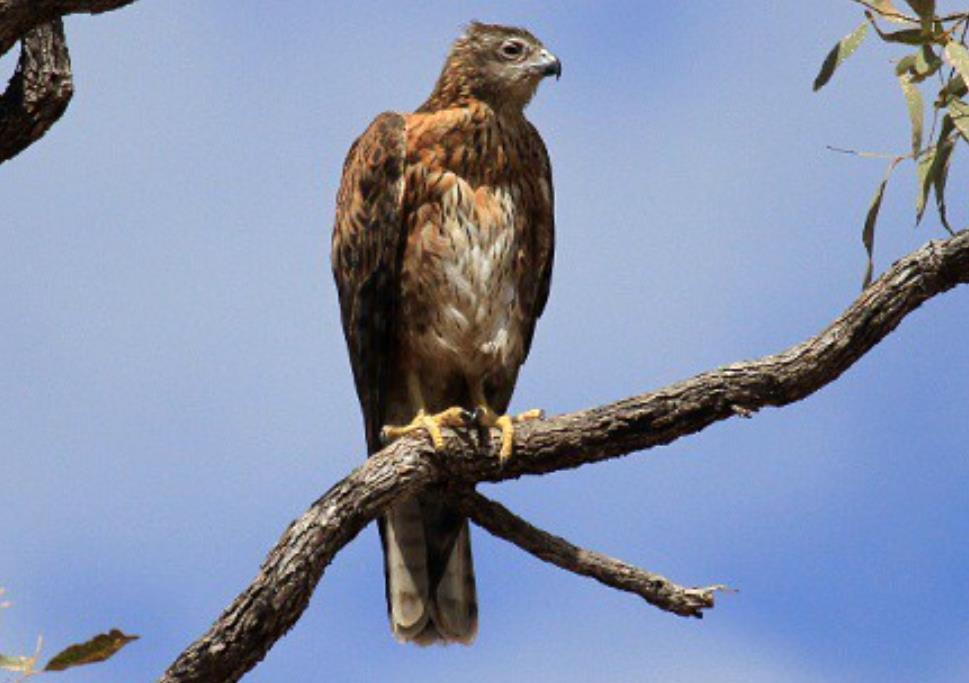Habitat: The Red Goshawk is a secretive and solitary bird in its northern habitat. The red goshawk is a rare and least-known bird of prey in Australia. Despite its imposing size and powerful talons as big as a small eagle’s, it is a secretive and solitary bird in its hunting and breeding habitat: the taller woodlands, open forests, and stream-side galleries of trees in northern Australia. They hunt from hidden vantage points in the forest early and late in the day. Being a diurnal species, this hawk spends its days in activity and its nights in rest. During the midday hours, they employ extended transects, quartering through or above the canopy, or conducting searches from an elevated flying position.
Feed: Like other goshawks, it hunts by stealth through and beneath the canopy of its woods, working from tree to tree and snatching unsuspecting prey from a perch, on the ground, or even in midair. Birds that are the main targets are honeyeaters, parrots, kookaburras, nestlings, herons, and other water birds, but it also takes occasional mammals, reptiles, and large insects. Much hunting is done at dusk and dawn. They may stoop from a height, glide stealthily, or pursue an object directly.

Behavior: Established pairs seem to occupy the same large territory and use the same nest year after year. Often, they hunt at least three kilometers from the nest. The female builds alone, taking about three weeks to refurbish the nest and lining it daily with green leaves. She appears to incubate and brood on her own as well, but she does leave once or twice a day, generally in the morning, to receive nourishment from the male. She eats it then and there and is rarely off the nest for more than 20 minutes. The male does all the hunting until the young are well-grown and calls the female off the nest to take his catches. After plucking and pulling them apart, she passes them on to the young. Only in the last weeks before fledging will the male drop food at the nest while the female is also away hunting.
Size: The red goshawk size is as below.
-
Length: 450–580 mm in length
-
Wingspan: 110–135 cm (43.7–53.5 inches)
-
Male Weight: 630–635 grams (22.3 oz)
-
Female Weight: 1100–1400 grams (38–49.38 oz)
Identification: Both adult sexes are identical; however, females are a little longer. The male resembles a female brown falcon, while the female is sized more like a whistling kite. The head and neck are white, heavily streaked dusky, with russet cast on the crown. Shoulders, back, and rump mottled dusky and russet, with broad russet scalloping on wing coverts. Flight feathers are gray barred black, lighter below; underwing coverts are russet. Tail mid-grey barred black, paler below. Chin and throat are white streaked dusky, becoming flushed with russet on streaked breast and belly; flanks, thighs, and undertail coverts are richer russet, without dusky streaks. The eyes are yellow. The bill is black, becoming grayer at the base; the cere is pale grey. Feet are heavy and yellow, and claws are black. The immature red goshawk is much russet than adults, with an entire undersurface cinnamon-rufous streaked dusky. Either that or Red Goshawks are dimorphic with a rufous-breasted phase. Eyes are brown. The downy young is snow-white, along with a dusky bill with a yellow gape.
Vocalizations: The red goshawk call is high-pitched chatter skeep-skeep-skeep-skeep when alarmed, otherwise not as rapid or as shrill as in other goshawks.
Nesting and Breeding: The red goshawk nesting and breeding occur in April-November during the dry season in the north; possibly only in August-November in the east. The nest is constructed in a tall emergent tree’s exposed fork. Nest made of sticks and twigs and green leaves in a vertical or horizontal fork 7–25 m above ground, 60–120 cm across, and 30–50 cm deep. Abandoned nests of crows or other hawks are sometimes rebuilt.
Eggs and Incubation: This raptor lays one or two eggs, slightly coarse; dull white to blue-tinged, sometimes sparsely blotched with brown, swollen-oval, 53–57 x 42–46 mm. The incubation period is about 40–42 days for females. Young fledge in 7-8 weeks. For two to three months, the young are dependent.
Distribution: The red goshawk is found in tropical open woodland, forest woodland, edges of rainforest, and dense riverine vegetation of coastal and subcoastal north and northeast, from the Kimberley, Western Australia, almost to Hunter River, New South Wales. The other important sites are Kakadu Savanna, Tiwi Islands, Mornington Sanctuary, and Lilyvale.
Family: The red goshawk (Erythrotriorchis radiatus) is a member of the goshawk subfamily Accipitridae in the genus Erythrotriorchis.
Lifespan: In the wild, red goshawks usually live between five and seven years, and their annual survival rate is approximately 83%.
Status: The red goshawk faces threats throughout its range and is classified as near-threatened. The major threats to this species include deforestation, illicit egg collection, and human interference in the nests.
Races: There are no races that exist.
Related Reading: Northern Goshawk – The Apex Predator of the Avian World







